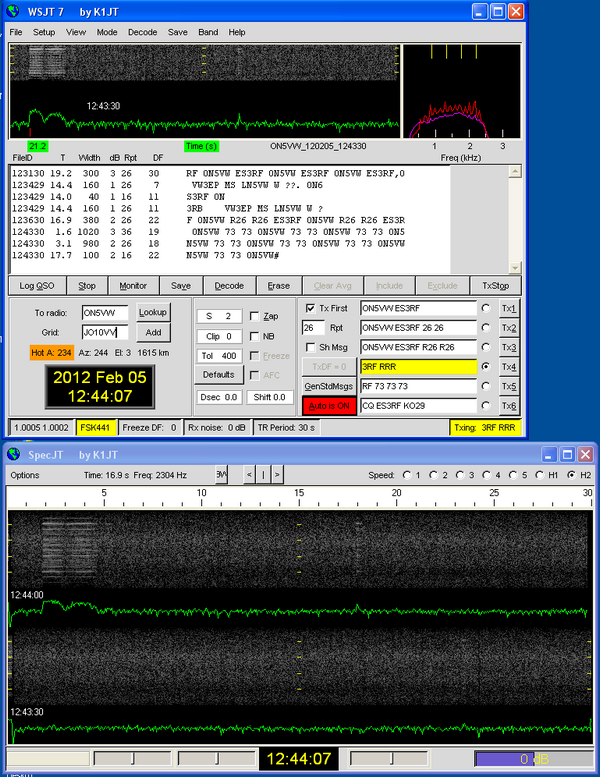








|
|
The meteor scatter (MS) is one of my favorite operations on
VHF.
My first HSCW (High Speed CW) QSO was in August 1981 during Perseides. At
this time I used
all home made equipment, included transceiver, transverter 144/28 MHz, 100 W
power amplifier
(GU-29 tube), home made programmable memory key, which gave me possibility
to transmit up to
1200 letters per minute and tape recorder with variable speed and ring tape.
And 7 elements QUAD antenna by GW4CQT.
As for a long time it was!
Please, check my Meteor Scatter
Logs by years.
Last update:
02.03.2012
MS Log before year 2001
MS Log - 2001
MS Log - 2002
MS Log - 2003
MS Log - 2004
MS Log - 2005
MS
Log - 2006
MS
Log - 2007
MS Log - 2008
MS Log - 2009
MS
Log - 2010
MS
Log - 2011
MS Log - 2012
Here is list of my initials MS by HSCW/SSB/WSJT on 2 meter band.
|
Below is a table of major annual meteor showers with ZHRs ≥ 20
(ZHR- Zenithal Hourly Rate of
meteors).
|
Shower |
Period
of Activity |
Maximum |
ZHR |
Velocity
(km/sec)
|
|
Quadrantids |
Jan 1 - 5 |
Jan 3 |
120 |
42 |
|
April
Lyrids |
Apr 16 - 25 |
Apr 22 |
15(90) |
48 |
|
Eta
Aquarids |
Apr 19 - May 12 |
May 5 |
60 |
66 |
|
Arietids |
May 29 - June19 |
June 7 |
60 |
37 |
|
z-Perseids |
May 20 - July 7 |
June 9 |
40 |
30 |
|
d-Aquarids |
July 12 - Aug 19 |
July 28 |
20 |
41 |
|
Perseids |
July 17 - Aug 24 |
Aug 12 |
>100(400) |
60 |
|
Orionids |
Oct 2 - Nov 11 |
Oct 21 |
20 |
66 |
|
Leonids |
Nov 14 - 21 |
Nov 17 |
20 |
71 |
|
Geminids |
Dec 7 - 17 |
Dec 14 |
110 |
35 |
|
Ursids |
Dec 17 - 26 |
Dec 22 |
>12(90) |
34 |
Here is
detailed calendar of
year meteor showers events from IMO (International Meteor
Organization)
|
|
One
of the most popular programs, using for Meteor Scatter QSO is a WSJT.
WSJT
is the name of a computer program. It stands for ''Weak
Signal
communication, by K1JT.''
The program currently supports four principal modes:
FSK441, designed to support communication using very brief
“pings” from meteor trails in the ionosphere;
JT6M, also for meteor scatter, but especially optimized for the
6-meter band;
JT65, ideal for extremely weak but slowly varying signals such as
those found on troposcatter and
Earth-Moon-Earth (EME) paths;
EME Echo mode for detecting and measuring your own echoes from
the moon.
The program also offers a Measure mode for testing Sun noise and EME
Calculator to help
you estimate the strength of your own and other stations’ echoes from
the moon.
Here is my FSK 441 MS QSO with ON5VW. So
easy to manage!
(Captured from the computer's screen).

|
|
Earth-Moon-Earth
(EME) activity. This is 4 x
18 elements yagi (2M18XXX) with original 4 port splitter and
phase cables.
All from by M2 Antenna System, Inc.


Middle of November 2007.
Middle of December 2007.
Array just 6 meter AGL. 8 x 19 ele.
yagi just erected.
Now array about.13 m AGL 17 meters AGL.
and has elevation rotator.
I started to
use my new PA (GS-35B) on 11.02.2009
with a very good results.
Antenna array 4x2M18XXX has elevation, limited to 45
degrees.
Follow to the
next link you will find list of
My initials on EME 2 meter band
Here are
my initials on EME 70 cm band
The table has
generated
by VQ_Log 3.1B
Last update:
02.03.2012
| NUM. |
DATE |
TIME |
CALLSIGN |
LOCATOR |
S/R |
REMARKS |
QRB |
| 1 |
16/12/2007 |
18:58 |
HB9Q |
JN47CG |
D/ D |
1st 70 cm EME QSO |
1714 |
| 2 |
07/11/2008 |
16:05 |
DK3WG |
JO72GJ |
D/D |
|
988 |
| 3 |
07/11/2008 |
16:11 |
I1NDP |
JN45AL |
B/B |
New # |
1891 |
| 4 |
07/11/2008 |
19:14 |
DL7APV |
JO62JR |
B/B |
|
1032 |
| 5 |
16/12/2008 |
00:02 |
UA3PTW |
KO93BS |
D/D |
|
1023 |
| 6 |
04/01/2009 |
16:56 |
GW3XYW |
IO71XR |
D/D |
New DXCC and # |
1980 |
| 7 |
04/01/2009 |
20:20 |
K2UYH |
FN20QG |
D/D |
New DXCC and # |
6728 |
| 8 |
04/01/2009 |
20:27 |
WA4NJP |
EN84DG |
D /D |
New # |
6786 |
| 9 |
18/04/2010 |
21:20 |
KP4AO |
FK68OI |
D/D |
|
8356 |
| 10 |
17/02/2011 |
21:46 |
DL5FN |
JO40FB |
/ |
|
1456 |
Number of initials listed: 8
Is it possible to work EME on a very short distances?
YES, OF
COURSE! |
| |
Home | My Station | HF | VHF-UHF-SHF | MS and EME | Satellites | QRP and Mobile | Photo Gallery | Technical page
This site was last updated
03/02/12
|



